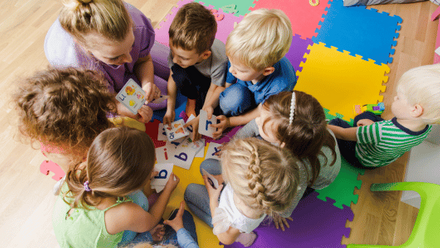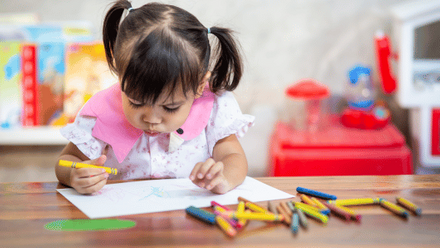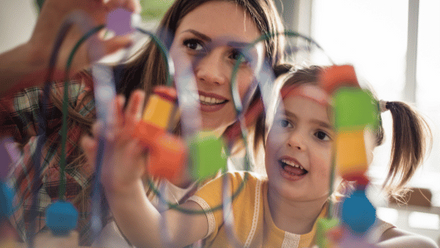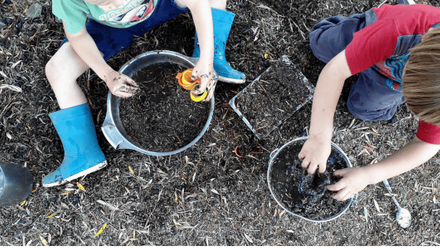How to create a communication friendly environment for a child with additional needs
All children have a right to be heard. Whether it’s responding to a baby’s cry, a toddler’s frustrations, or a pre-schooler’s saga that they relay whilst cooking in the roleplay area, communicating and interacting with children is a core principle of the work we do as early education and care professionals. However, some children find communicating with people more challenging than others. Children with special educational needs can benefit from additional support to communicate with friends and adults.
This article explores how we communicate with young children and why it is important to create a communication friendly environment for all children to feel welcome, safe and heard.
What do we mean by communication?
What do we mean when we talk about communication? It requires two foundational skills, listening and understanding, and it revolves around how we take meaning from someone else’s expression, interpret it and respond to it.
But the first thing that often comes to mind is actually a more advanced aspect of communication. That’s language – the development of the vocabulary we listen to and the language we speak in order to receive and convey messages. For children who are acquiring vocabulary at an expected developmental rate, the words they learn become their primary way to communicate their thoughts and needs. Because it is the most common way to communicate, speech becomes a primary thought when we think of how children communicate with us.
All children communicate in various ways, from how they move their body to the marks they make when they draw. For children with additional needs other forms of communication are equally as important for being able to connect with the world around them when the difficulties they face include how they use speech and language.
Other forms of communication include:
- pointing and gesturing, including sign language or visual supports
- verbal cues – anything from screaming and shouting to huffing and gasping
- body language, including the speed of movements, how they use a space or where they are looking during an interaction
- written communication, including drawings and mark-making activities...
… and so much more! Everything we do communicates a need, a thought or an emotion to those around us.
Whilst the words we speak and what we hear are a big part of communication for able-bodied people, the world is rich with a plethora of other ways to express ourselves with others.
In the UK, 1.9 million children are currently struggling with understanding words and talking to others. Despite the recovery programmes and support initiatives provided by the government and third sector organizations in the aftermath of the COVID-19 pandemic, the health crisis has contributed to a rapid increase in the number of children with speech and language challenges, which increased from 1.5 million in 2021 to 1.9 million in 2023.
How we communicate with others has a massive impact on every part of our lives, from our education to our health and wellbeing, and everything in between. For children who struggle with aspects of communication and interaction, supportive provisions can transform their life experiences from early years onwards.
How to make the environment more communication friendly
We’ve established that communication is variable and unique to us all. We know that inclusive environments are key to improving outcomes for all children. But how do we make our environment ‘communication friendly’ for everyone?
It’s important to note that some children will need further targeted support for their learning. This means that their additional needs extend beyond the support that can be given by making a learning space as inclusive as possible but that they may need more specific aid, such as a 1-1 member of staff or personal care routine.
The tips below are focused on improving the whole provision to remove as many barriers as possible for all children, commonly known as universal provision.
Single words and short phrases
For all children in their early years, using single words and short sentences helps to build a great understanding of vocabulary and its meaning. Using full and complex sentences can become confusing for children who are still learning to extract key information from lengthy conversation.
For children with special educational needs, who might struggle to process language, using single words and simple phrases allows us to highlight keywords in language and build meaning to the words we use, rather than simply parroting language we hear. It is only then that we can begin to extend on vocabulary and start to form sentences that make real sense.
Repeat, repeat, repeat
Just like acquiring any new skill, all communication strategies take time to embed in our practice. Whether this be modeling a sign, speaking a new word or forming a new facial expression, it is important to repeat and repeat and repeat to consolidate knowledge and form connections between what is conveyed and how it is interpreted. Repetition in a whole class provision is helpful because it allows for children with a slower processing ability to gain the same understanding from a learning moment as their neurotypical peers.
Autistic children might communicate by repeating words they don’t necessarily understand the meaning of, rather than using them to communicate for its definition’s sake. This is known as echolalia and is often a response used when they don’t know the specific answer or understand what has been said. This is different from repeating vocabulary or actions to consolidate meaning so using a different strategy, such as visual aid cards, can support understanding in a different way that repetition might not aid.
Making things visual
Visual supports come in a variety of forms, such as short videos, small visual cards, now/next boards and timers, but can also be implemented in simple ways based on how the environment is set up. We can look at things that stay in the environment for longer than we hear a word spoken. For children with processing difficulties, this can make the world of difference to the autonomy they take in their learning. Visual cards can be used to label drawers so that children can independently find things they need whilst using transparent storage can be useful to allow children to gesture and see where things are if they need help accessing them.
Visual supports can also be used as single words or to create a sequence so they allow us to extend vocabulary and communication in a similar way to how we might extend speech and language. Their versatility to use pre-designed or specially made visual resources allow children to customise their language and express themselves on a personal level that contributes further to their voice being heard in the setting.
In conclusion...
Our ability to communicate is key to understanding our place in the world, who we are and what we relate to. It involves listening to others, rather than just hearing what they mean by interpreting their messages and responding in kind.
For children with special educational needs, elements of communication can be difficult to access. For example, children with a hearing impairment might not be able to interact in group settings in the same way as children with healthy hearing. For children with a speech impediment, talking to others might get frustrating if they can’t use the words they want. For children with processing needs, the rate at which our environment moves and the language that is used can become confusing very quickly.
As professionals in early education and care, developing an inclusive and supportive environment for children of all abilities to develop a love for their own unique language is vital to ensuring a positive attitude to communication in the years to come, building a strong sense of belonging and confidence for every child we care for.






